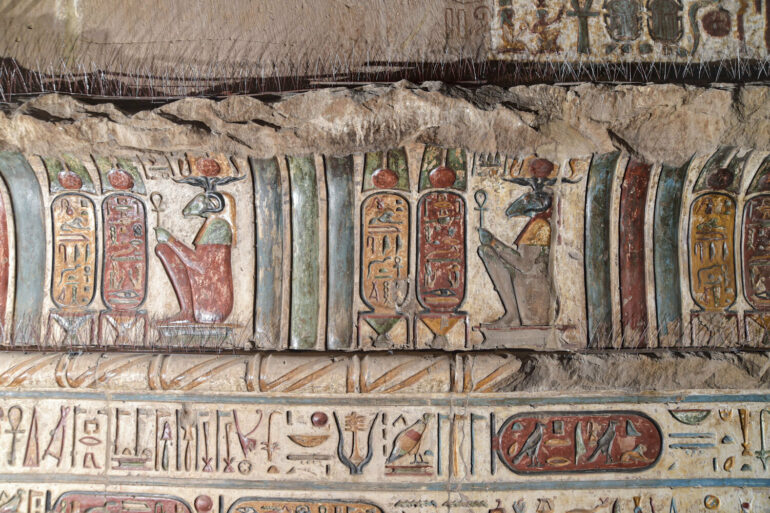The Roman-era temple of Esna, 60 kilometers south of Luxor in Egypt, is undergoing extensive restoration work in an Egyptian-German cooperation project. The temple proper no longer exists, but the large vestibule or pronaos was rediscovered more than 200 years ago and is complete.
The restoration work has been in progress since 2018. On the Egyptian side it is led by Hisham El-Leithy from the Ministry of Tourism and Antiquities (MoTA) Documentation Center; on the German side, by Egyptologist Professor Christian Leitz from the Institute of Ancient Near Eastern Studies at the University of Tübingen.
Over the past 1,800 years, local people lit fires in the temple vestibule. As a result, the once-colorful wall and column decorations were blackened. Over the past six years, a team of up to 30 Egyptian restorers led by Ahmed Emam revealed the colors of the astronomical images covering the entire ceiling as well as the colors of the 18 inner columns.
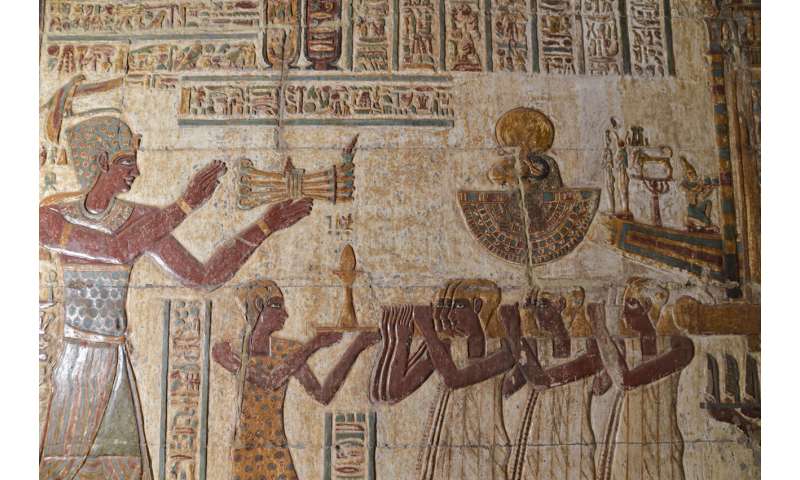
The king sacrificing four incense burners before Khnoum’s holy barque. In front of him is the sem-priest, wearing a leopard skin and making an offering of a potter’s wheel to the creator god Khnoum. © University of Tübingen
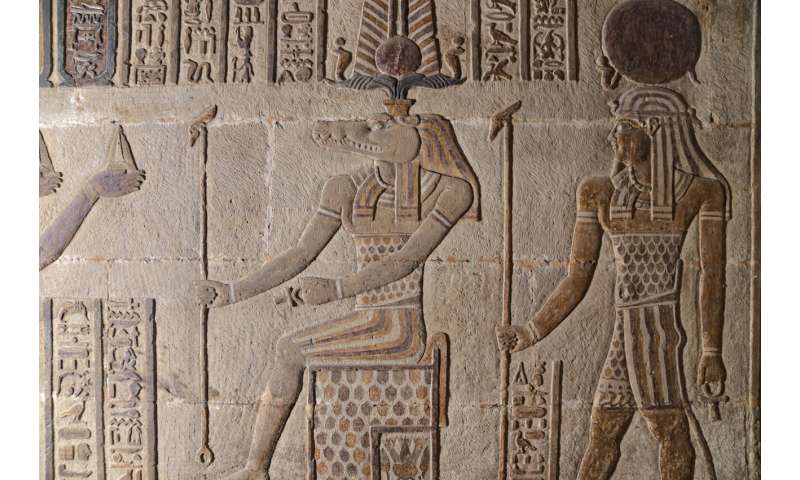
The local crocodile god Shemanefer with many fine details painted on his crown, wig, apron and throne. © University of Tübingen
Yellow and red predominate
A new phase of restoration began this year. Specialists finished restoring the southern inner wall and the southern part of the western rear wall. They brought to light the original colors with dominant yellow and red pigments, marking a sharp difference from color schemes found elsewhere, for example at the temple of Dendara, where white and light blue predominate.
“The greatest discovery this year was the many painted details of the clothing on the king and the deities of Esna, their crowns and their thrones,” says Christian Leitz. “Previously, we could not see them at all due to the thick layer of soot over the reliefs.”
All these painted details are an integral part of the offering scenes which cover the inner walls of the temple. Researchers knew about the hieroglyphic texts and the reliefs; but the freshly uncovered decorations on the throne images have their own meaning.
In one scene—an offering of bow and arrow to the goddess Neith—the conservation team uncovered four painted bows in the lower part of the throne—perhaps part of originally nine bows, a reference to the “nine bows” as a designation for Upper and Lower Egypt and seven other territories ruled by the king of Egypt.
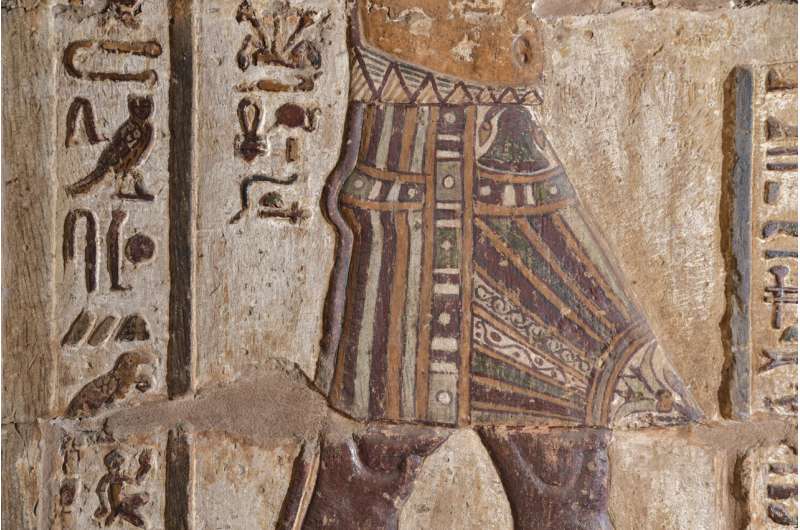
The king’s apron with plant decoration. The papyrus (top) is the emblem of Lower Egypt and the lily (bottom) the emblem of Upper Egypt. © University of Tübingen
Another example is the apron of the king in one of the offering scenes. It is decorated with two plants: The papyrus (top) is the emblem of Lower Egypt and the lily (bottom) the emblem of Upper Egypt, symbolizing that the king is the ruler of the two parts of the country.
Perhaps the most spectacular scene is the one with the holy barque of the local deity Khnoum which carries the shrine of the god. This boat is carried by several priests who are bringing it out from the innermost part of the temple in a procession, so that on special occasions the people of Esna could at least see the closed shrine of the god. For the rest of the year, it was hidden in the temple to which only the priests had access.
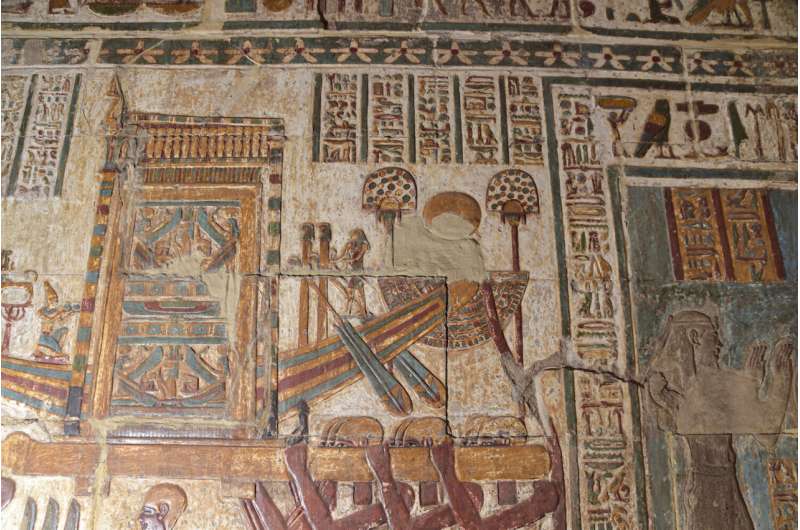
The holy barque with the shrine of Khnoum, the main deity of Esna, carried by several priests. © University of Tübingen
The conservation work will resume at the beginning of November. The main goal for the next winter season is the cleaning of the outer part of the six front columns of the temple. This cannot be done in summer due to the great heat. The Esna temple restoration work is sponsored by the Ancient Egypt Foundation, the American Research Center in Egypt and the Gerda Henkel Foundation.
The pronaos
The pronaos of the temple in Esna is 37 meters long, 20 meters wide and 15 meters high. It is a sandstone structure which was erected in front of the actual temple building before or during the reign of the Roman Emperor Claudius (41–54 AD) and was probably much larger than the temple itself.
Its location in the middle of the city center probably contributed to the fact that the vestibule was preserved and was not used as a quarry for building materials as other ancient edifices were during the industrialization of Egypt. Even in Napoleon’s time, the pronaos attracted attention among scholars, as it was considered an ideal example of ancient Egyptian temple architecture.
Provided by
University of Tübingen
Citation:
New paintings and details uncovered in the Egyptian temple of Esna (2024, October 22)
